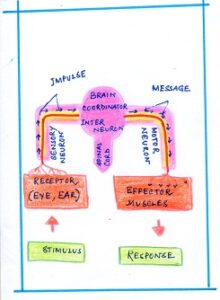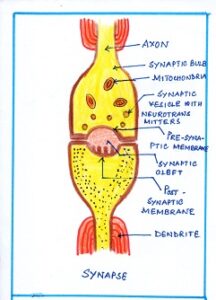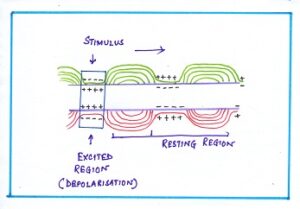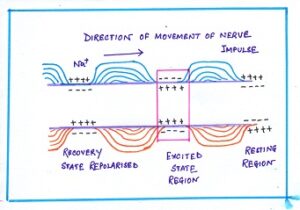NERVOUS SYSTEM IMAGES
INTRODUCTION:
We perform many activities consciously or unconsciously, for example, when we eat food, our eyes help to locate the food, the nose smells it, hands bring food to the mouth, teeth chew and masticate it, the tongue pushes the food inside the alimentary canal, and so on. (NERVOUS SYSTEM FUNCTION) All these activities occur in a coordinate manner. The organ system in our body that brings about coordination and integration of body activities, is the nervous system. ( NERVOUS SYSTEM FUNCTION)
FUNCTIONS:
The nervous system acts like a two-way communication system. The impulses are carried from the tissues and organs to the nerve centers and from the nerve centers, the messages are carried to the desired tissues and organs.
- It receives the changes in the external environment by the receptors and after interpreting and analyzing, sends the appropriate messages to the effectors. The sensory organs like eyes, ears, tongue, nose and skin help to receive stimulus from the environment.
- It conducts information and transmit messages to various parts of the body. ( NERVOUS SYSTEM FUNCTION)
- It stimulates and inhibits the activities of various muscles and glands according to the kind of information received.
- It receives and coordinates the activities of various visceral organs in the body.
- By coordinating different activities, it helps to maintain stready state of the body.
TYPES OF NERVES ( NERVOUS SYSTEM FUNCTION)
There are three types of nerves depending upon the direction in which they transmit the impulse.
- Sensory nerve: These are also called afferent nerves( afferent: carry toward). These nerve contain neurons which carry messages (impulse) from sensory receptors in sensory organs towards the central nervous system i.e brain and spinal cord.
Example: Optic nerve from eye leading to the brain.
Motor nerve: These are also called efferent nerves(efferent: to carry away). As these type of nerves carrys messeges from the central nervous system to the effector organs, such as muscles and glands. (NERVOUS SYSTEM FUNCTION )
Example: Nerves arising in brain and leading to the muscles of the eyeball.
Mixed nerves: These are many nerves that are comprised of both afferent( sensory) and efferent(motor) nerve fibres. These are called mixed nerves
Example: most cranial and spinal nerves are mixed nerves.
.(NERVOUS SYSTEM FUNCTION)STRUCTURE OF A NEURON
Neurons vary in shape and size depending on their position and function, but all neurons have a similar basic structure
1)A neuron possesses three distinct region
i) cell body or cyton
ii)dendrites
iii)axon.
2)Cell body or cyton contains a nucleus and abundant cytoplasm. ( NERVOUS SYSTEM FUNCTION)
*In the cytoplasm are embedded numerous cell organelles like mitochondria, Golgi apparatus, endoplasmic reticulum etc.
*The cytoplasm also contains prominent nissl’s granules associated with protein synthesis. They are absent in the axon.
*From the cell body extend out two kinds of protoplasmic extension- dendrites and axon. ( what is meant by the ” polarised state” of resting nerve fibre?)
3)Dendrites are short and branched processes. They have numerous fine branches which carry the impulse towards the cell body.
4)Axon is a long process, may be several centimeters long. It transmits or conducts nerve impulses away from the cell body or cyton. It is in the form of an elongated fibre with terminal end fibres having swollen knob. The swollen knobs store chemically called neurotransmitter like acetyle choline which are released at the synapse on stimulation of axon. The axons communicate with other neurons through synapse.
5)Axon is surrounded by a number of Schwann cell.
*These cells may secrete a fatty insulating layer called myelin sheath around the axon in some neurons. Axons with myelin sheath are called myelinated nerve fibres. ( what is meant by the ” polarised state” of resting nerve fibre?)
*The myelin sheath is not continuous. It is interrupted at regular intervals called nodes of Ranvier.
*Axons without myelin sheath are called non-myelinated nerve fibre.
*Myelinated nerve fibers conduct nerve impulses at a far greater speed than non-myelinated ones in myelinated fibers, nerve impulse jumps from one node of Ranvier to another node.
COMMUNICATION THROUGH THE NERVE- NERVE IMPULSE
Through the receptors the neurons of nervous system a stimulus,which is integratesd or coordinated i, and shows the effects of response through the effector organs. Thus, a coordinated behavior has six main components-
STIMULUS, IMPULSE, RECEPTOR, COORDINATOR, EFFECTOR and RESPONSE ( NERVOUS SYSTEM FUNCTION)
In such a coordinated behavior, any stimulus of sound, sight, smell etc. is perceived by receptor organs like eyes, ears, skin etc.

- STIMULUS: It is an agent or sudden external or internal change that results in a change in activities of an organism.
- IMPULSE: It is a wave of chemical disturbances that travels through the nerve cell.
- RECEPTORS: These are sensory organs which receive stimulus and send wave in front of impulse towards the CNS.
- EFFECTORS: These are the muscles or organs which show response due to motor nerves. Response is a change that occurs in an organism due to stimulus.
- COORDINATOR: Here CNS act as coordinator.
- RESPONSE: The brain and spinal cord are coordinators which receive information in the form of messages called nerve impulse from receptors organs via neurons. The information flows to the effector organs i.e. muscles which contract or relax to show response
SYNAPSE: Synapse is ajunction or space between two neurons. It is between the axon of neuron and dendrite of another neuron. There is no physical connection between the neuron and synapse to be passed on to other neuron.

At the synapse, a chemical called acetyl choline is released from the swollen knobs of the axons that transmits impulse from one neuron to another . Hence the chemical is called a neurotransmitter. ( NERVOUS SYSTEM FUNCTION)
AT RESTING STATE- POLARISED STATE ( NERVOUS SYSTEM FUNCTION)

At normal or resting state, the outer side of nerve fibres carry more positive(+) charge due to more Na+ ions outside the axon membrane. This is called a polarized state.
AT STIMULATED (EXCITED) STATE-DEPOLARISATION
When the axon membrane receives the stimulus then it becomes more permeable at the receiving place to Na+ move inside causing loss of polarity i.e. depolarization. This region becomes excited region. This region of depolarization moves forward to next area which in turn becomes depolarized.

RETURNING TO NORMAL STATE- REPOLARISATION ( NERVOUS SYSTEM FUNCTION)

The area which has received stimulus becomes repolarised due to the active transport of Na+ ions outside. This active transport is performed by SODIUM PUMP for which ATP acts as an energy carrier. Thus, conduction of nerve impulse is a wave of depolarization followed by repolarisation.